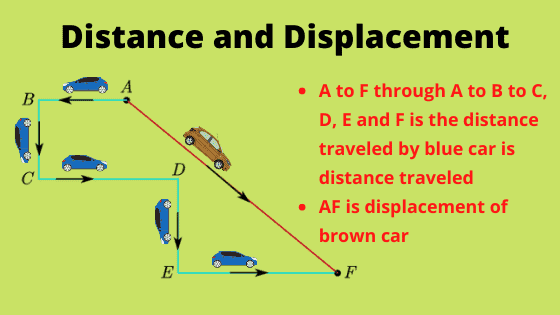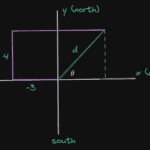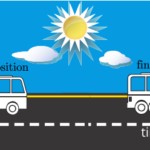
In this article learn about distance and displacement in physics. Also learn about the difference between these two quantities distance and displacement.
Before learning what is distance and displacement do not forget to check our article on How to find position in physics.
Get more articles in kinematics.
Now that we know how to describe the position of a particle moving along a straight line at a given time, we will now learn about distance and displacement.
In our day-to-day language, we use terms distance and displacement interchangeably but in physics, both terms have different meanings.
What is distance?
The Length of the actual path between the initial and final position of the moving object in the given time interval is known as the distance traveled by the object.
Distance Definition
To explain this further let us take our example where a man starts moving towards the right of the tree we are using as a reference point.

Now at t = 10 minute he is at 10 meters from the reference point O. Let’s call this point as A. He then starts to move towards left and at t = 8 minute he is 5 meters from the origin. Let’s call this point as B
So, distance traveled by a man going from O to A is equal to 10 meters and distance traveled in going from A to B is equal to 5 meters.
The total distance traveled is equal to OB. So,
\(OB = OC + AB\)
Putting in the values we get
\(OB= 10\,\, meter + 5\,\, meter =15 \,\, meters\)
So, here we are considering the actual length of the path traveled by the man between initial point O and final point B.
What is Displacement?
Let us now define the term displacement.
Displacement is the shortest distance between the initial position and the final position of a moving object in the given interval of time along with its direction.
Displacement Definition
Let us now find the displacement of the man moving from his initial position O to position A and then to position B. Here to find the displacement of the man from the initial position to final position we must have knowledge of
- How far the final position is from the initial position, which is nothing but the straight-line distance between initial and final positions.
- The direction of the final position as seen from the initial position.
Now going back to our example let us now find the displacement of man from his initial position.
Displacement is equal to straight line distance between points O and B which is equal to OB. Here O is the initial position and B is the final position.
From the above figure, displacement is equal to
\(OB= 5\,\,meters\) towards the right of origin O.
This straight-line distance between initial and final positions of a particle is called the magnitude of the displacement
Also note that we have mentioned the direction in our example which is ‘towards the right’ or ‘right direction’ of the reference point or origin.
So, displacement has both magnitude and direction whereas distance traveled has magnitude but no direction.
Difference between distance and displacement
Let us now look at the differences between distance and displacement.
The first one is the displacement of an object may be zero but the distance traveled by the object is never zero.
To explain this further again consider that in our example the man travels to point A, then to point B and finally returned to reference point O then
\(Distance = OA + OB + BO\)
\(= 10\,\, meters + 5\,\, meters + 5\,\, meter= 20\,\, meters\)
Now, displacement, in this case, would be zero since O is the initial as well as the final position of the man.
Again, if any object is moving along a circular path, starts at point A and return to point A then the total distance covered would be \(2 \pi r\) but the net displacement of the object would be zero. So,
Distance traveled by a moving body cannot be zero but the final displacement of a moving body can be zero.
We have also discussed earlier that displacement of an object can be negative but distance traveled by an object can never be negative.
Another difference between distance and displacement is that
Distance is a a scalar quantity that is it only has magnitude and no direction is specified.
Whereas displacement is a vector quantity as it has both magnitudes and direction.
For example, if a car travels a distance of 60 Km then this ’60 kilometer’ is the distance traveled.
Again, if the car is moving in straight line towards west then the displacement of the car of the car would be expressed as ’50 kilometer towards west’.
Watch this video on position, distance and displacement for a clear idea.
Related Articles
- Concept maps on motion
- youtube video on distance and displacement in physics





